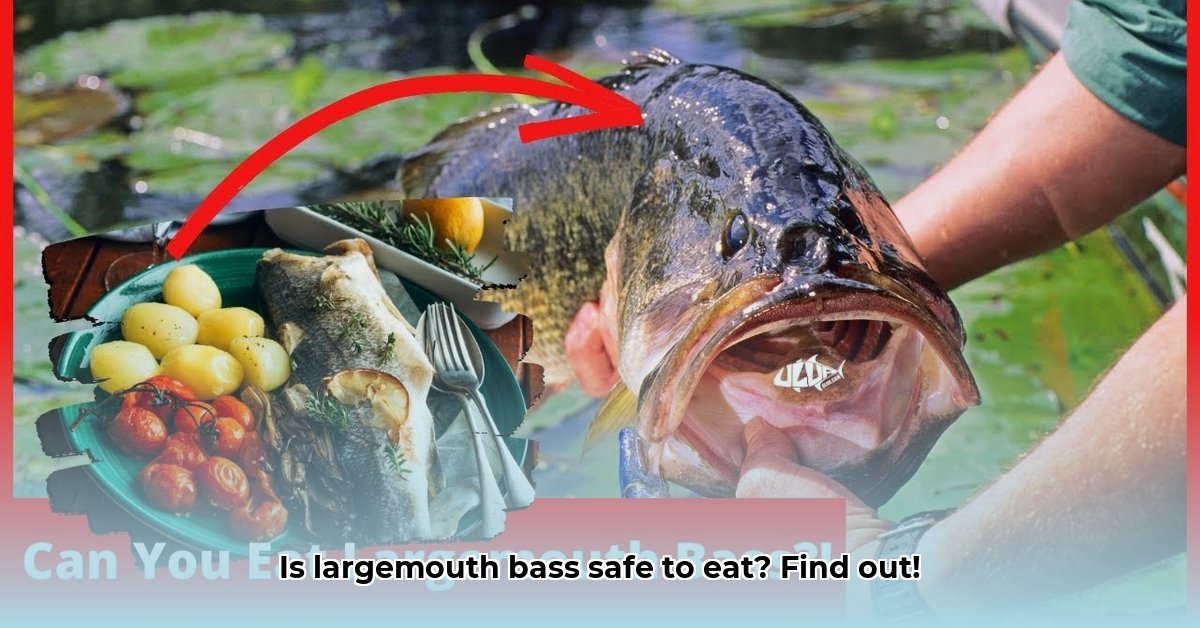So, you’re wondering if largemouth bass is good to eat? It’s a great question, and the answer isn’t a simple yes or no. Think of it like this: a perfectly cooked bass fillet can be unbelievably delicious, but there’s more to it than just taste. For information on other healthy fish options, check out this guide on grouper health. This guide gives you the whole picture, from how its flavor changes depending on where and when it’s caught, to the best ways to cook it so it’s absolutely amazing. We’ll also talk about sustainable fishing – making sure there are plenty of bass for everyone to enjoy – and whether there are any health concerns. Basically, everything you need to know to make smart decisions about eating this popular fish.
Unlocking Largemouth Bass Potential: A Guide on Safe Consumption
Let’s dive into the delicious (and sometimes tricky) world of largemouth bass! Is it really healthy to eat and are there hidden benefits? The short answer is: it can be, but it’s not quite as straightforward as a simple yes or no. This comprehensive guide will help you navigate the waters of safe and sustainable largemouth bass consumption, and give you the knowledge about sustainable fishing practices.
Decoding Largemouth Bass Flavors: Habitat and Seasonal Impacts
The flavor of largemouth bass is surprisingly versatile, depending on several factors: its size, where it lived, and the time of year. Just like seasonal fruits and vegetables, largemouth bass’s flavor profile varies.
Smaller bass, typically weighing between one and two pounds, often boast a milder, sweeter flavor, a testament to their younger years spent in cleaner waters. However, larger bass (think five pounds or more) might have a slightly earthier taste, which some people actually prefer. This change of flavor happens as the fish matures. Some anglers and chefs claim that the bass caught during spring and fall have the most desirable flavor. The water’s mineral composition and the presence of algae significantly influence the taste. Clearer waters usually produce better-tasting bass.
Nutritional Fish Profile: Benefits, Risks, and Mercury Levels
Largemouth bass offers a healthy dose of lean protein, essential minerals like calcium and magnesium, and omega-3 fatty acids, incredibly beneficial for heart health and overall well-being. Omega-3s are known for their anti-inflammatory properties and their positive effects on brain function, while lean protein is essential for building and repairing tissues, helping you stay energized and supporting a strong immune system. A 3-ounce serving contains approximately 20 grams of protein, making it an ideal food.
However, like many fish, largemouth bass can accumulate mercury and other environmental toxins from their water sources. The level of mercury contamination can vary widely depending on the cleanliness of the water. Smaller bass from cleaner lakes and rivers are generally considered safer choices in terms of mercury contamination, while larger fish, having lived longer lives, have had more time to accumulate these toxins. Certain bodies of water may also contain PCBs or dioxins, so checking local advisories is essential.
Pregnant women, nursing mothers, and young children should be particularly cautious.
It’s crucial to check local fish consumption advisories before eating any largemouth bass. These advisories, often issued by state or local health departments, provide vital information about the mercury levels in fish from specific bodies of water. These advisories will often provide guidelines on the frequency of consumption based on location and size of fish.
Cooking Tips & Tricks: Turning Catch into Culinary Art
Proper preparation is key to unlocking the delicious potential of this game fish. Decide how you want to cook your bass. Fillet it for easy cooking, leaving you with boneless portions, or for a rustic approach, leave it whole or scale it, preserving the integrity of the fish.
Cooking Methods: A Culinary Symphony:
- Pan-frying: This method delivers crispy skin and succulent, flaky flesh. Use a high-heat oil with a high smoke point, such as canola or avocado oil. Pat the fillets dry before pan-frying to achieve maximum crispness.
- Grilling: Grilling infuses the bass with a smoky flavor, creating a delicious outdoor meal. Marinate the fish beforehand to enhance the taste and prevent sticking to the grill.
- Baking: Baking provides even cooking, ideal for larger whole bass or fillets. Season generously with herbs and spices and consider wrapping the fish in parchment paper or foil to retain moisture.
- Air Frying: For a quicker, healthier alternative, air frying creates a crispy exterior with a tender interior. Lightly coat the fish with oil and season generously.
If you’re concerned about a muddy flavor, especially in larger bass, try soaking the fillets in milk or buttermilk for about 30 minutes before cooking. This soak helps to neutralize any undesirable tastes. Adding aromatic ingredients like lemon juice, garlic, fresh herbs (dill, parsley, thyme), or a splash of white wine can also significantly enhance the flavor profile. Brining the fillets for 15-20 minutes before cooking can improve the texture and moisture content.
Ethical Angler’s Guidelines: Sustainable Fishing for Future
Responsible fishing practices are essential for maintaining healthy bass populations for generations to come. Always adhere to local size and bag limits, ensuring you only keep a sustainable number of fish. Many states and local governing bodies have regulations designed to protect fish populations, which make sure that fish stocks remain healthy for the future. For larger bass, consider catch-and-release. Larger fish are more likely to hold higher levels of pollutants, making catch-and-release not only beneficial to the fish population but also potentially beneficial to your health!
Beyond regulations, consider the impact of your fishing gear. Using barbless hooks reduces injury to the fish, especially if practicing catch and release. Avoid fishing during spawning seasons to allow the fish to reproduce and replenish their populations.
Sustainable Choices: How to Select Quality Bass for Consumption
When purchasing largemouth bass from a market or fishmonger, opt for reputable sources committed to sustainable practices. Look for certifications from organizations like the Marine Stewardship Council (MSC) or the Aquaculture Stewardship Council (ASC). Locally sourced bass from well-managed fisheries is often a more sustainable choice. This ensures your meal is both delicious and ethical.
Final Thoughts: Largemouth Bass as a Sustainable Food Source
So, is largemouth bass healthy to eat? The answer remains a qualified “yes,” but it requires careful consideration. Check consumption advisories from your local government. Responsible fishing practices are an essential part of ensuring long-term sustainability of largemouth bass populations and the environment. By being informed and making conscious choices, you can enjoy delicious meals while contributing to a healthier planet.
How to Cook Small Largemouth Bass for Optimal Flavor
Freshness is paramount. The sooner you prepare your catch, the better the taste.
Key Takeaways:
- Largemouth bass, while delicious, can sometimes have a muddy taste. Proper handling and cooking methods are key to unlocking its best flavors.
- The size of your bass matters: Smaller fish tend to have a milder flavor.
- Freshness is paramount. The sooner you prepare your catch, the better the taste.
- Several cooking methods, from pan-frying to baking, work well with small largemouth bass.
- Sustainable fishing practices are crucial for preserving this valuable resource.
Examining Flavor Profile: Factors that Influence the Taste
Largemouth bass flavor varies wildly. Factors like habitat, seasonality, and size all play a role. Smaller bass often possess a more delicate taste, less prone to that sometimes muddy flavor. Water clarity influences the presence of geosmin and MIB (2-Methylisoborneol), compounds that contribute to that muddy taste. Cooler, clearer water usually yields a cleaner-tasting fish. The diet of the bass contributes profoundly to the flavor profile. Bass who consume a higher amount of crustaceans will usually have a cleaner and preferable taste.
Nutrient Density: Balancing Health Benefits and Potential Risks
Largemouth bass boasts excellent nutritional value. Like any fish, potential contaminants exist, therefore always be mindful of your source and the origins of the fish.
A 3-ounce (85-gram) serving of largemouth bass contains approximately:
- Calories: 110-130
- Protein: 20-25 grams
- Fat: 2-4 grams (including omega-3 fatty acids)
- Vitamin D: Varies, but can be a good source
- Vitamin B12: Significant amount
- Selenium: Good source
- Calcium and Magnesium: Present in smaller amounts
Detailed Cooking Guide: Step-by-Step to Perfection
Preparation is Key:
- Bleeding is Crucial: Immediately after catching the fish, bleed it by cutting the gills or severing the spinal cord. This prevents blood from seeping into the flesh and causing a muddy flavor.
- Gutting and Cleaning: Clean the fish thoroughly by removing its innards quickly. Rinse well under cold water. Remove any bloodlines along the spine.
- Scaling (Optional): Scaling depends on your preference, but removing scales is generally recommended for a better texture. Use a descaler or the back of a knife.
Cooking Methods for Optimal Flavor:
- Pan-frying: A quick and easy method. Use a high-heat oil with a high smoke point (like canola or avocado oil). Season simply with salt, pepper, and perhaps some lemon. Cook until flaky and opaque, about 3-5 minutes per side for smaller fish. Don’t overcrowd the pan.
- **Baking
- Bento Box Glass Offers Practical, Eco-Friendly Meal Storage - December 16, 2025
- The Best Bento Box Price For Your Perfect Packed Lunch - December 15, 2025
- Bento Box Shopping Tips for Smart and Stylish Lunch Prep - December 14, 2025










